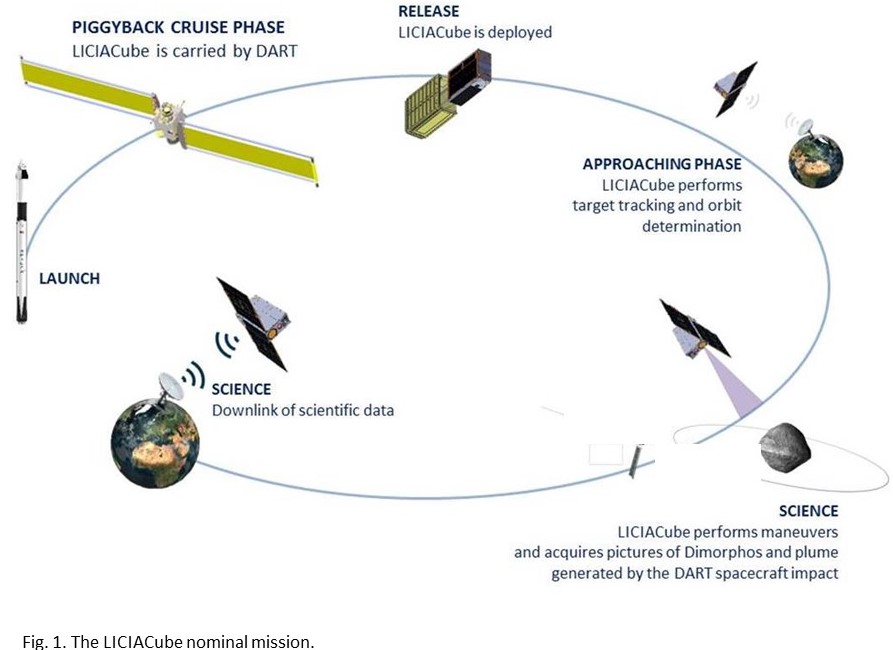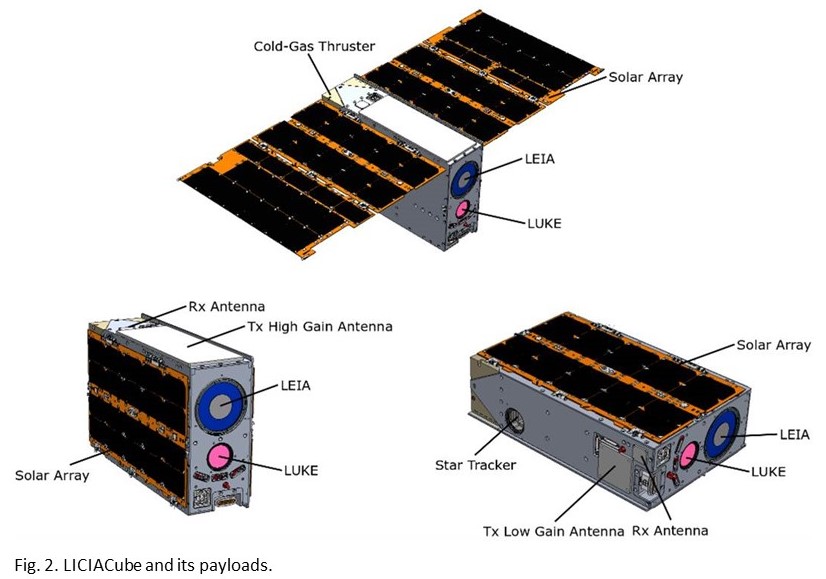LICIACube – the Light Italian Cubesat for Imaging of Asteroid onboad DART
- 1INAF-Osservatorio Astronomico di Roma, Porzio Catone (Roma), Italy (elisabetta.dotto@inaf.it)
- 2INAF Istituto di Astrofisica e Planetologia Spaziali, Roma, Italy
- 3Agenzia Spaziale Italiana, Roma, Italy
- 4Università degli Studi di Napoli "Parthenope", Napoli, Italy
- 5INAF Osservatorio Astrofisico di Arcetri, Firenze, Italy
- 6Politecnico di Milano, Italy
- 7Argotec, Torino, Italy
- 8INAF Osservatorio Astronomico di Padova, Italy
- 9Università di Bologna, Bologna, Italy
- 10INAF Osservatorio Astronomico di Trieste, Italy
- *A full list of authors appears at the end of the abstract
Introduction.
Besides being objects of great scientific interest, Near-Earth Asteroids (NEAs) also represent a potential threat to human life and civilization. Several space mission concepts have been proposed to prevent the collision of a NEA on course towards Earth, most of them aiming to slightly deflect it from its catastrophic orbit. Among them, the so-called “kinetic impactor” is currently considered the most mature one. This technique is based on a momentum transfer imparted via an impactor spacecraft launched into an interplanetary intercept trajectory that crashes onto the asteroid at high velocity, changing its orbit. DART will be the first test in real scale of this technique. With a mass of 650 kg and an impact velocity of about 6.6 km/s, DART is expected to change the binary orbital period of Dimorphos, the 160-m moon of Didymos (780-m in size), by about 10 min, an effect that can be easily measured by ground-based telescopes (Rivkin et al. 2021; Cheng et al. 2018).
LICIACube is the first purely Italian spacecraft to be operated in deep space, it is managed by ASI and it is under development by a large team of engineers and scientists, with the aim to contribute in the NASA DART Planetary Defence objective (Dotto et al. 2021).
LICIACube Mission Scenario
LICIACube will be launched with DART, hosted as a piggyback and released 10 days before the DART impact and autonomously guided along its fly-by trajectory (see Fig. 1). The aim of this mission is to testify the DART impact and obtain multiple images of the ejecta plume, of the impact site and of the nonimpact hemisphere.
After commissioning phase and braking and correction maneuvers LICIACube will approach the target at a minimum distance of about 55 km, and will perform the scientific phase during the asteroid’s fly-by (Capannolo et al. 2021).
After that, LICIACube will downlink the obtained images directly to Earth. The architecture of the LICIACube Ground Segment is based on the Argotec Mission Control Centre, antennas of the NASA Deep Space Network and data archiving and processing, managed at the ASI Space Science Data Center where images are planned to be integrated in the MATISSE tool (Zinzi et al, 2016; 2019) for visualization and analysis.

The LICIACube payload and observing strategy
The LICIACube mass is about 13 kg: it is developed by Argotec and equipped with two different payloads named LEIA and LUKE (Fig. 2).
LEIA (Liciacube Explorer Imaging for Asteroid) is a narrow FoV camera able to acquire images with a spatial scale close to 1.4 m/px at the minimum distance of about 55 km, while LUKE (Liciacube Unit Key Explorer) is a wide FoV imager with an RGB Bayer pattern filter.
LEIA and LUKE will offer the opportunity to obtain a unique science return, investigating for the first time the nature of a binary NEA. Comparing the impact and non-impact regions, as well as studying the nature and the evolution of the produced dust plume, will allow us to deeply investigate the composition and the structure of the material composing a small double NEA.

As a general approach each planned observation will be formed by a sequence of different images acquired at the maximum frame rate possible and possibly with different integration times.
Starting from about 45 s before T0, the nominal DART impact time, five different acquisition phases have been foreseen (Fig. 3). DART impact observation (red); Ejecta observation (yellow); High resolution observation of the surface properties and the crater (blue); Non-impact hemisphere observation (green); Plume evolution in forward scattering (purple).

Data Exploitation
The navigation radiometric data acquired during the scheduled tracking passes, along with the images collected before and during the encounter, will be used for an opportunity radio science experiment, to put constraints on the gravity of Didymos.
Images acquired by LEIA and LUKE will allow us to constrain the shape and volume of Dimorphos as well as its physical properties.
High-resolution images, obtained by LEIA at the closest approach, will allow us to study the surface morphology of Dimorphos and the presence of boulders/large blocks on its surface. By comparing pre- and post-impact surface areas we will have the unique opportunity to witness how the boulders size-frequency distribution and density changed as a result of the DART impact.
The LUKE data will give us also the opportunity to investigate the composition of Dimorphos throughout spectrophotometric analyses. So we will be able to map the surface composition of the object and to derive the surface heterogeneity at the observed scale.
The images of the plume, compared with numerical models of dust dynamics, will allow us to have measurements of the motion of the slow ejecta and to estimate the structure of the plume.
References.
Capannolo A., et al. (2021), Acta Astronautica, Volume 182, p. 208.
Cheng A. F., et al. (2018) PSS, 157, 104.
Dotto E., et al. (2021) PSS, 199, id. 105185
Rivkin A.S., et al. (2021) Planetary Science Journal, in press.
Zinzi A. et al. (2016) Astron. Comput., 15, 16-28.
Zinzi A. et al. (2019) EPSC-DPS Joint Meeting 2019, id. EPSC-DPS2019-1272.
Acknowledgements. The LICIACube team acknowledges financial support from Agenzia Spaziale Italiana (ASI, contract No. 2019-31-HH.0 CUP F84I190012600).
Pasquale Palumbo (Università "Parthenope", Italy; INAF-IAPS, Italy), Davide Perna (INAF-OAR, Italy), Simone Pirrotta (ASI, Italy), Giovanni Poggiali (INAF-OAA; Università Firenze, Italy), Alessandro Rossi (IFAC-CNR, Italy), Emanuele Simioni (INAF-OAPd, Italy), Simone Simonetti (Argotec, Italy), Paolo Tortora (Università Bologna, Italy), Marco Zannoni (Università Bologna, Italy), Giovanni Zanotti (Politecnico Milano, Italy), Angelo Zinzi (ASI-SSDC, Italy), Andy F. Cheng (JHU/APL, USA), Andrew S. Rivkin (JHU/APL, USA), Elena Y. Adams (JHU/APL, USA), Edward L. Reynolds (JHU/APL, USA), Kristin Fretz (JHU/APL, USA)
How to cite: Dotto, E., Della Corte, V., Amoroso, M., Bertini, I., Brucato, J. R., Capannolo, A., Cotugno, B., Cremonese, G., Di Tana, V., Gai, I., Ieva, S., Impresario, G., Ivanovski, S. L., Lavagna, M., Lucchetti, A., Mazzotta Epifani, E., Meneghin, A., Miglioretti, F., Modenini, D., and Pajola, M. and the LICIACube team: LICIACube – the Light Italian Cubesat for Imaging of Asteroid onboad DART, Europlanet Science Congress 2021, online, 13–24 Sep 2021, EPSC2021-160, https://doi.org/10.5194/epsc2021-160, 2021.

